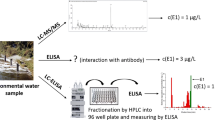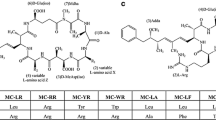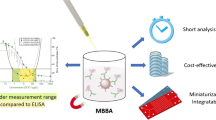Abstract
The non-steroidal anti-inflammatory drug (NSAID) diclofenac (DCF) is found worldwide in the aqueous environment. Therefore, it has raised increased public concern on potential long-term impact on human health and wildlife. The importance of DCF has been emphasized by the European Union recently by including this pharmaceutical in the first watch list of priority hazardous substances in order to gather Union-wide monitoring data. Rapid and cheap methods of analysis are therefore required for fresh and wastewater monitoring with high sample load. Here, for the first time, well-characterized monoclonal antibodies (mAbs) against DCF were generated and a highly sensitive ELISA developed. The best antibody (mAb 12G5) is highly affine (KD = 1.5 × 10−10 M), stable to potential matrix interferences such as pH value (pH range 5.2–9.2), calcium ion concentration (up to 75 mg/L), and humic acid content (up to 20 mg/L). The limit of detection (LOD, S/N = 3) and IC50 of the ELISA calibration curve were 7.8 and 44 ng/L, respectively. The working range was defined between 11 and 180 ng/L. On average, about 10 % cross-reactivity (CR) was found for DCF metabolites 5-OH-DCF, 4’-OH-DCF, and DCF-acyl glucuronide, but other structurally related NSAIDs showed binding <1 % compared to the parent compound. While DCF concentrations at the low ppt range were measured in river and lake water, higher values of 2.9 and 2.1 μg/L were found in wastewater influents and effluents, respectively. These results could be confirmed by solid phase extraction combined with LC-MS.





Similar content being viewed by others
Abbreviations
- BSA:
-
Bovine serum albumin
- CCS:
-
Cell culture supernatant
- CR:
-
Cross-reactivity
- DCF:
-
Diclofenac
- DCF-GLU:
-
Diclofenac-acyl glucuronide
- ELISA:
-
Enzyme-linked immunosorbent assay
- HRP:
-
Horseradish peroxidase
- IC50 :
-
Molar analyte concentration giving 50 % inhibition
- LOD:
-
Limit of detection
- LOQ:
-
Limit of quantification
- OVA:
-
Ovalbumin
- PBS:
-
Phosphate buffered saline
- PBST:
-
PBS with 0.05 % Tween 20
- RT:
-
Room temperature
- SPE:
-
Solid phase extraction
- SPR:
-
Surface plasmon resonance
- TG:
-
Thyroglobulin
- TMB:
-
Tetramethylbenzidine
References
Kosma CI, Lambropoulou DA, Albanis TA (2014) Investigation of PPCPs in wastewater treatment plants in Greece: occurrence, removal and environmental risk assessment. Sci Total Environ 466–467:421–438. doi:10.1016/j.scitotenv.2013.07.044
Benner J, Helbling DE, Kohler H-PE, Wittebol J, Kaiser E, Prasse C, Ternes TA, Albers CN, Aamand J, Horemans B, Springael D, Walravens E, Boon N (2013) Is biological treatment a viable alternative for micropollutant removal in drinking water treatment processes? Water Res 47:5955–5976. doi:10.1016/j.watres.2013.07.015
Petrie B, Barden R, Kasprzyk-Hordern B (2015) A review on emerging contaminants in wastewaters and the environment: current knowledge, understudied areas and recommendations for future monitoring. Water Res 72:3–27. doi:10.1016/j.watres.2014.08.053
Sorensen JPR, Lapworth DJ, Nkhuwa DCW, Stuart ME, Gooddy DC, Bell RA, Chirwa M, Kabika J, Liemisa M, Chibesa M, Pedley S (2015) Emerging contaminants in urban groundwater sources in Africa. Water Res 72:51–63. doi:10.1016/j.watres.2014.08.002
Bouissou-Schurtz C, Houeto P, Guerbet M, Bachelot M, Casellas C, Mauclaire A-C, Panetier P, Delval C, Masset D (2014) Ecological risk assessment of the presence of pharmaceutical residues in a French national water survey. Regul Toxicol Pharmacol 69:296–303. doi:10.1016/j.yrtph.2014.04.006
Richardson SD, Ternes TA (2011) Water Analysis: emerging contaminants and current issues. Anal Chem 83:4614–4648. doi:10.1021/ac500508t
Gros M, Rodriguez-Mozaz S, Barceló D (2013) Rapid analysis of multiclass antibiotic residues and some of their metabolites in hospital, urban wastewater and river water by ultra-high-performance liquid chromatography coupled to quadrupole-linear ion trap tandem mass spectrometry. J Chromatogr A 1292:173–188
Maier MP, De Corte S, Nitsche S, Spaett T, Boon N, Elsner M (2014) C & N isotope analysis of diclofenac to distinguish oxidative and reductive transformation and to track commercial products. Environ Sci Technol 48:2312–2320. doi:10.1021/es403214z
Schwaiger J, Ferling H, Mallow U, Wintermayr H, Negele RD (2004) Toxic effects of the non-steroidal anti-inflammatory drug diclofenac Part I: histopathological alterations and bioaccumulation in rainbow trout. Aquat Toxicol 68:141–150. doi:10.1016/j.aquatox.2004.03.014
Triebskorn R, Casper H, Heyd A, Eikemper R, Köhler H-R, Schwaiger J (2004) Toxic effects of the non-steroidal anti-inflammatory drug diclofenac Part II: cytological effects in liver, kidney, gills and intestine of rainbow trout (Oncorhynchus mykiss). Aquat Toxicol 68:151–166. doi:10.1016/j.aquatox.2004.03.015
Mehinto AC, Hill EM, Tyler CR (2010) Uptake and biological effects of environmentally relevant concentrations of the non-steroidal anti-inflammatory pharmaceutical diclofenac in rainbow trout (Oncorhynchus mykiss). Environ Sci Technol 44:2176–2182. doi:10.1021/es903702m
Corcoran J, Winter MJ, Tyler CR (2010) Pharmaceuticals in the aquatic environment: a critical review on the evidence for health effects in fish. Crit Rev Toxicol 40:287–304. doi:10.3109/10408440903373590
Kallio J-M, Lahti M, Oikari A, Kronberg L (2010) Metabolites of the aquatic pollutant diclofenac in fish bile. Environ Sci Technol 44:7213–7219. doi:10.1021/es903402c
Memmert U, Peither A, Burri R, Weber K, Schmidt T, Sumpter JP, Hartmann A (2013) Diclofenac: new data on chronic toxicity and bioconcentration in fish. Environ Toxicol Chem 32:442–452. doi:10.1002/etc.2085
Brozinski J-M, Lahti M, Meierjohann A, Oikari A, Kronberg L (2013) The anti-inflammatory drugs diclofenac, naproxen and ibuprofen are found in the bile of wild fish caught downstream of a wastewater treatment plant. Environ Sci Technol 47:342–348. doi:10.1021/es303013j
Oaks JL, Gilbert M, Virani MZ, Watson RT, Meteyer CU, Rideout BA, Shivaprasad HL, Ahmed S, Chaudry MJI, Arshad M, Mahmood S, Ali A, Khan AA (2004) Diclofenac residues as a cause of vulture population decline in Pakistan. Nature 427:630. doi:10.1038/nature02317
Knopp D, Deng A, Letzel M, Himmelsbach M, Zhu Q-Z, Peröbner I, Kudlak B, Frey S, Sengl M, Buchberger W, Taggart M, Hutchinson C, Cunningham A, Pain D, Cuthbert R, Raab A, Meharg A, Swan G, Jhala Y, Prakash V, Rahmani A, Quervedo M, Niessner R (2007) Immunological determination of the pharmaceutical diclofenac in environmental and biological samples. In: Rational Environmental Management of Agrochemicals: Risk Assessment, Monitoring, and Remedial Action, vol 966. ACS Symp Ser, ACS Washington, pp 203–226. doi:10.1021/bk-2007-0966.ch013
Saini M, Taggart MA, Knopp D, Upreti S, Swarup D, Das A, Gupta PK, Niessner R, Prakash V, Mateo R, Cuthbert RJ (2012) Detecting diclofenac in livestock carcasses in India with an ELISA: a tool to prevent widespread vulture poisoning. Environ Pollut 160:11–16. doi:10.1016/j.envpol.2011.09.011
Sharma AK, Saini M, Sing SD, Prakash V, Das A, Bharathi Dasan R, Pandey S, Bohara D, Galligan TH, Green RE, Knopp D, Cuthbert RJ (2014) Diclofenac is toxic to the Steppe Eagle Aquila nipalensis: widening the diversity of raptors threatened by NSAID misuse in South Asia. Bird Conserv Int. doi:10.1017/S0959270913000609
Directive 2013/39/EU of the European Parliament of 12 August 2013; OJEU L 226/1-L 226/17
Reemtsma T, Weiss S, Mueller J, Petrovic M, González S, Barcelo D, Ventura F, Knepper TP (2006) Polar pollutants entry into the water cycle by municipal wastewater: a European perspective. Environ Sci Technol 40:5451–5458. doi:10.1021/es060908a
Osorio V, Imbert-Bouchard M, Zonja B, Abad J-L, Pérez S, Barceló D (2014) Simultaneous determination of diclofenac, its human metabolites and microbial nitration/nitrosation transformation products in wastewaters by liquid chromatography/quadrupole-linear ion trap mass spectrometry. J Chromatogr A 1347:63–71. doi:10.1016/j.chroma.2014.04.058
Deng AP, Himmelsbach M, Zhu QZ, Frey S, Sengl M, Buchberger W, Niessner R, Knopp D (2003) Residue analysis of the pharmaceutical diclofenac in different water types using ELISA and GC-MS. Environ Sci Technol 37:3422–3429. doi:10.1021/es0341945
McEneff G, Barron L, Brian K, Brett P, Quinn B (2014) A year-long study of the spatial occurrence and relative distribution of pharmaceutical residues in sewage effluent, receiving marine waters and marine bivalves. Sci Total Environ 476–477:317–326. doi:10.1016/j.scitotenv.2013.12.123
Ternes TA (1998) Occurance of drugs in German sewage. Water Res 32:3245–3260. doi:10.1016/S0043-1354(98)00099-2
Sun Z, Schüssler W, Sengl M, Niessner R, Knopp D (2008) Selective trace analysis of diclofenac in surface and wastewater samples using solid-phase extraction with a new molecularly imprinted polymer. Anal Chim Acta 620:73–81. doi:10.1016/j.aca.2008.05.020
Buchberger W (2011) Current approaches to trace analysis of pharmaceuticals and personal care products in the environment. J Chromatogr A 1218:603–618. doi:10.1016/j.chroma.2010.10.040
Silva CP, Lima DLD, Schneider RJ, Otero M, Esteves VI (2013) Development of ELISA methodologies for the direct determination of 17β-estradiol and 17α-ethinylestradiol in complex aqueous matrices. J Environ Manag 124:121–127
Kanso H, Barthelmebs L, Inguimbert N, Noguer T (2013) Immunosensors for estradiol and ethinylestradiol based on new synthetic estrogen derivatives: application to wastewater analysis. Anal Chem 85:2397–2404. doi:10.1021/ac303406c
Farré M, Brix R, Kuster M, Rubio F, Goda Y, López de Alda MJ, Barceló D (2006) Evaluation of commercial immunoassays for the detection of estrogens in water by comparison with high-performance liquid chromatography tandem mass spectrometry HPLC–MS/MS (QqQ). Anal Bioanal Chem 385:1001–1011. doi:10.1007/s00216-006-0562-7
Bahlmann A, Carvalho JJ, Weller MG, Panne U, Schneider RJ (2012) Immunoassays as high-throughput tools: monitoring spatial and temporal variations of carbamazepine, caffeine and cetirizine in surface and wastewaters. Chemosphere 89:1278–1286. doi:10.1016/j.chemosphere.2012.05.020
Nagaraj VJ, Jacobs M, Vattipalli KM, Annam VP, Prasad S (2014) Nanochannel-based electrochemical sensors for the detection of pharmaceutical contaminants in water. Environ Sci Processes Impacts 16:135–140. doi:10.1039/C3EM00406F
Meulenberg EP, Peelen GOH, Lukkien E, Koopal K (2005) Immunochemical detection methods for bioactive pollutants. Int J Environ Anal Chem 85:861–870. doi:10.1080/03067310500158180
Li D, Wei S, Yang H, Li Y, Deng A (2009) A sensitive immunochromatographic assay using colloidal gold-antibody probe for rapid detection of pharmaceutical indomethacin in water samples. Biosens Bioelectron 24:2277–2280. doi:10.1016/j.bios.2008.11.004
Tschmelak J, Kumpf M, Proll G, Gauglitz G (2004) Biosensor for seven sulphonamides in drinking, ground, and surface water with different matrices. Anal Lett 37:1701–1718. doi:10.1081/AL-120037597
Shelver WL, Shappell NW, Franek M, Rubio FR (2008) ELISA for sulfonamides and its application for screening in water contamination. J Agric Food Chem 56:6609–6615. doi:10.1021/jf800657u
Zhang Z, Liu J-F, Shao B, Jiang G-B (2010) Time-resolved fluoroimmunoassay as an advantegous approach for highly efficient determination of sulfonamides in environmental samples. Environ Sci Technol 44:1030–1035
Smith J, Sammons D, Robertson S, Biagini R, Snawder J (2010) Measurement of multiple drugs in urine, water, and on surfaces using fluorescence covalent microbead immunosorbent assay. Toxicol Mech Method 20:587–593. doi:10.3109/15376516.2010.518172
Brun EM, Bonet E, Puchades R, Maquieira A (2008) Selective enzyme-linked immunosorbent assay for triclosan. Application to wastewater treatment plant effluents. Environ Sci Technol 42:1665–1672. doi:10.1021/es702300s
Dolliver H, Kumar K, Gupta S, Singh A (2008) Application of enzyme-linked immunosorbent assay analysis for determination of monensin in environmental samples. J Environ Qual 37:1220–1226. doi:10.2134/jeq2007.0394
Riemer AB, Gruber S, Pali-Schöll I, Kinaciyan T, Untersmayr E, Jensen-Jarolim E (2010) Suppression of gastric increases the risk of developing immunoglobulin E-mediated drug hypersensitivity: human diclofenac sensitization and a murine sensitization model. Clin Exp Allergy 40:486–493. doi:10.1111/j.1365-2222.2009.03363.x
Rau S, Hilbig U, Gauglitz G (2014) Label-free optical biosensor for detection and quantification of the non-steroidal anti-inflammatory drug diclofenac in milk without any sample pretreatment. Anal Bioanal Chem 406:3377–3386. doi:10.1007/s00216-014-7755-2
Pschenitza M, Gavrilova ES, Tarasov SA, Knopp D, Niessner R, Epstein OI (2014) Application of a heterogeneous immunoassay for the quality control testing of release-active forms of diclofenac. Int Immunopharmacol 21:225–230. doi:10.1016/j.intimp.2014.04.029
Acknowledgments
This work was co-financed by ANR (Agence Nationale de la Recherche) - DFG (Deutsche Forschungsgemeinschaft) program, project ‘NArBioS’ (grant ANR-11-INTB-1013). We appreciate the generous gifts of metabolites 5-OH-DCF (from Dr. Gregory Roth† Sandford Burnham Medical Institute in Orlando, USA) and 4-’OH-DCF and DCF-GLU (from Dr. Ron Scialis, University of Connecticut, Storrs, USA). Further, we thank Thermo Fisher Scientific Inc. for the generous support.
Conflict of interest
The authors declare that they have no competing interest.
Author information
Authors and Affiliations
Corresponding author
Electronic supplementary material
Below is the link to the electronic supplementary material.
ESM 1
(PDF 156 kb)
Rights and permissions
About this article
Cite this article
Huebner, M., Weber, E., Niessner, R. et al. Rapid analysis of diclofenac in freshwater and wastewater by a monoclonal antibody-based highly sensitive ELISA. Anal Bioanal Chem 407, 8873–8882 (2015). https://doi.org/10.1007/s00216-015-9048-9
Received:
Revised:
Accepted:
Published:
Issue Date:
DOI: https://doi.org/10.1007/s00216-015-9048-9




